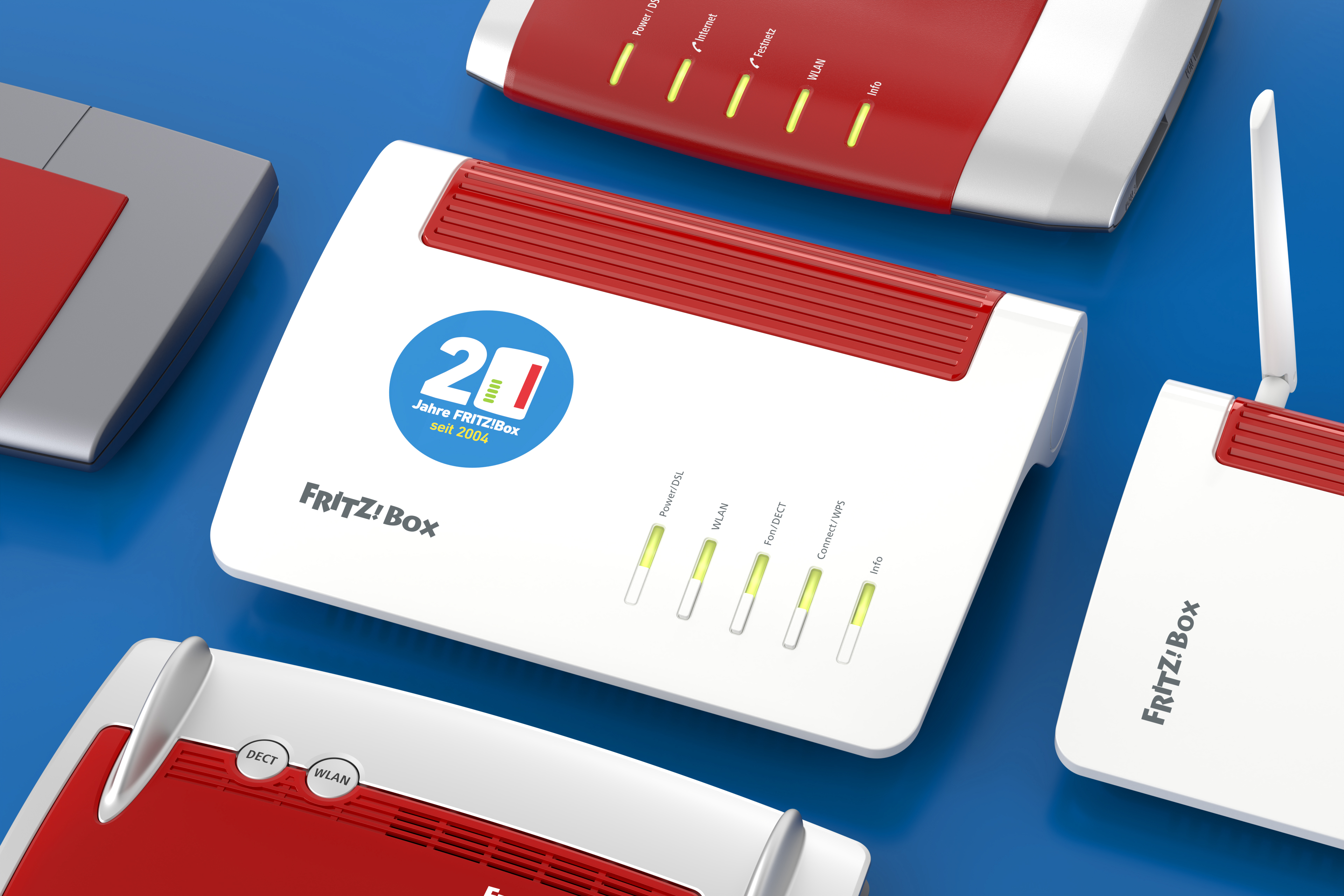AVM Content
A look back at the FRITZ!Box

20 years ago, in the fall of 2004, the first FRITZ!Box from AVM with Wi-Fi on board was released. Since the launch of the FRITZ!Box, AVM has made a significant contribution to changing the way people work, communicate and live. At its Berlin headquarters, AVM develops and optimizes the FRITZ!Box by developing reference designs from Wi-Fi chipset manufacturers, giving customers optimal Wi-Fi connectivity for 20 years. It's a fitting occasion to look back at the most important milestones in the Wi-Fi history of the FRITZ!Box at AVM:
2004: The first FRITZ!Box – the beginning of a success story
In 2004, AVM launched the first FRITZ!Box. Thanks to considerable initiative in software development and hardware design, an innovative combination consisting of a DSL modem and router was created. In contrast to network interface cards that were installed into a computer, several end devices could now "surf" the internet simultaneously via a LAN or USB connection at up to 8 Mbit/s. And wireless extension was already in the starting blocks. The FRITZ!Box SL WLAN was released in the fall of the same year and achieved speeds of up to 54 Mbit/s via the IEEE 802.11g standard. Thanks to the wireless access point integrated directly into the FRITZ!Box, several devices could now access the internet wirelessly and at the same time.
2007: Wi-Fi 4 is introduced – faster, further, more stable
With the introduction of Wi-Fi 4 (802.11n) in 2007, the demands on routers also increased. The first iPhone came onto the market and set the course for a new era of multi-user Wi-Fi. To cope with the increased number of end devices, a second Wi-Fi band, the 5GHz frequency band, with more bandwidth was introduced. At this time, the FRITZ!Box 7270 achieved data transfer rates of up to 450 Mbit/s and, thanks to two frequency bands, could connect more devices to the internet at the same time and with minimal interference. It was a revolution when it came to using the first streaming services and online gaming without a LAN connection.
2013: Wi-Fi 5 – a new speed record
The introduction of Wi-Fi 5 (802.11ac) required a revision of the FRITZ!Box hardware – resulting in the FRITZ!Box 7490, which has Wi-Fi speeds of up to 1300 Mbit/s and to this day doesn't need to take a back seat. It enables a smooth browsing experience with multiple devices, even when the network is being heavily used. This meant that Wi-Fi was beginning to replace cables as the preferred connection technology in many homes and offices. With the introduction of 1 gigabit speeds, Wi-Fi was increasingly approaching or even surpassing the performance of wired connections.
2019: Mesh Wi-Fi – seamless coverage throughout the home
AVM has expanded its Mesh Wi-Fi technology, guaranteeing seamless Wi-Fi coverage throughout the entire home network. The FRITZ!Box and other mesh-capable FRITZ! products now worked together with even more synergy. With the constantly evolving FRITZ!OS, users now had convenient device management, resulting in a powerful and uniform network that adapted dynamically to their diverse needs. This was an important step a a time when smart washing machines, fridges and robot vacuums were becoming increasingly widespread. The seamless integration of these appliances into everyday life made the concept of the smart home increasingly attractive.
2021: Wi-Fi 6 – Faster, more efficient and more devices at the same time
With the launch of the FRITZ!Box 7590 AX in 2021, Wi-Fi 6 made its way into the FRITZ!Box. Not only does the model achieve higher speeds of up to 3,600 Mbit/s, but it also offers improved efficiency and capacity for a large number of simultaneously connected devices. This is because the Wi-Fi standard can manage the simultaneous data traffic of IoT devices much better. At a time when smart homes and networked devices are becoming increasingly popular, the FRITZ!Box creates an anchor point for your connection.
2024: More bandwidth, low latency – Wi-Fi 7 is coming
Today, the seventh generation of Wi-Fi has already found its way into the FRITZ!Box portfolio. In addition to using the new, third 6 GHz frequency band, the performance of wireless networks can be further increased. With Wi-Fi 7 and a tri-band configuration, the FRITZ!Box 5690 Pro achieves speeds of up to 11,530 Mbit/s and enables FRITZ! users to help shape the digital world of tomorrow. The low latency times and improved network capacity ensure real-time experiences without noticeable delays in virtual reality (VR), for example. These advances enable smooth VR interactions and immersive, latency-free applications, even in heavily loaded networks with multiple devices connected at the same time.
Find out more about AVM and the latest FRITZ!Box models at en.avm.de and en.avm.de/20-years-of-fritzbox.
Press images and videos: en.avm.de/about-avm/press/press-media